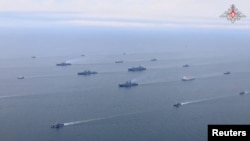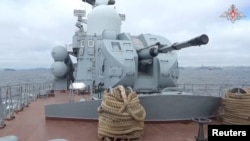Russia says it launched massive naval and air drills Tuesday that span a huge swath of oceans and involve more than 400 naval vessels, at least 120 military aircraft and upwards of 90,000 troops.
The large-scale military exercise, dubbed “Ocean-2024,” includes forces from China and will run until September 16 with at least 15 countries invited to observe the maneuvers, according to the Russian Defense Ministry.
Russian President Vladimir Putin said Russia pays “special attention” to strengthening military cooperation with “friendly states” and warned the United States not to try and outgun Moscow in Asia.
"Under the pretext of countering the allegedly existing Russian threat and containing the People's Republic of China, the United States and its satellites are increasing their military presence near Russia's western borders, in the Arctic, and in the Asia-Pacific region,” Putin said in a televised remark to Russian military officials on Tuesday. He said Washington and its allies are "openly declaring their plans to deploy medium- and shorter-range missiles in the so-called forward zones.”
Analysts say the joint naval and air drills are an effort by Russia and China to deepen military ties and counter increased security coordination between the United States and its allies in the Indo-Pacific region.
“Russia wants to demonstrate that they can engage in a full-scale war with Ukraine while deploying resources to the Indo-Pacific region and China wants to show that they can deepen its relationship with Russia and cause problems in the region, primarily in the South China Sea but also around Japan,” said Stephen Nagy, a regional security expert at the International Christian University in Japan.
On Monday, the Chinese defense ministry said both countries would conduct joint naval and aerial exercises aimed at deepening bilateral strategic cooperation and strengthening their ability to respond to security threats in the waters and airspace near the Sea of Japan and the Sea of Okhotsk.
In addition to the joint exercise near Japan, the Chinese defense ministry said Chinese and Russian naval fleets will conduct their fifth joint patrol in the Pacific Ocean as part of the "Ocean-2024" strategic exercise.
“Russia hopes to increase pressure on the United States on the Pacific front through the joint military exercise with China, which may force Washington to reduce its military deployment to Europe,” said Lin Ying-yu, a military expert at Tamkang University in Taiwan.
On the other hand, he added that China hopes to divert Japan’s attention from waters near the Taiwan Strait through its closer military partnership with Russia.
“Japan will have to prioritize threats to their security so they won’t have more bandwidth to focus on the situation across the Taiwan Strait,” Lin told VOA in a phone interview.
China and Russia’s increased military cooperation near Japan in recent years has prompted Tokyo to characterize their joint activities as a “grave concern.”
“These repeated joint activities are clearly intended for demonstration of force against Japan and are a grave concern from the perspective of the national security of Japan,” the Japanese defense ministry wrote in its annual defense white paper, which was released in July.
For now, Nagy said Japan is more concerned with how the military cooperation may evolve, adding that there are still limits to what the two can do together when they conduct exercises.
“Japan will be concerned about whether the coordination between China and Russia will be used to destabilize sea lines of communication, to prop up North Korea, or to move towards some kind of forced reunification with Taiwan,” he told VOA in a phone interview. “The Russians and Chinese will sail beside each other, fly next to each other, or coordinate how their boats move around but they haven’t developed interoperability and inter-command.”
Enhancing logistics, communication collaboration
While there are limits to their cooperation, other analysts say Russia and China will still use joint military exercises to enhance their cooperation in logistics, such as exchanging parts, fuel, or services or sharing data or communication channels.
“The ability for the Chinese and Russian armies to better understand one another and better support each other in the field is an important capability to develop for both countries,” Drew Thompson, a visiting senior research fellow at the Lee Kuan Yew School of Public Policy in Singapore, told VOA by phone.
In addition to that, Lin in Taipei said China could also enhance its forces’ combat capabilities through joint military exercises with Russia since the Russian forces have accumulated real combat experiences from Moscow’s war in Ukraine.
“Since Russia’s navies have dealt with drone or anti-ship missile attacks launched by Ukraine, the Chinese navy could learn about how to deal with similar attacks in a potential war across the Taiwan Strait from their Russian counterparts,” he told VOA.
Pushing back against NATO
China and Russia’s upcoming military exercise near Japan is part of their growing efforts to push back against the United States and NATO allies. Since July, Beijing and Moscow have held at least three joint military drills in different parts of the world, including the South China Sea, the skies off coastal Alaska, and the Gulf of Finland.
“These increased military drills all over the world are part of Beijing and Moscow’s efforts to counter the deepening defense coordination between the U.S. and its allies, both in Europe and in the Pacific,” Sari Arho Havren, an associate fellow at the Royal United Services Institute, told VOA in a phone interview.
Despite their attempt to challenge the U.S. and NATO through closer military cooperation, Nagy said China and Russia are unlikely to let their partnership escalate out of proportion.
“Russia and China will continue to reciprocate what the U.S. and its allies are doing, but not escalate since Beijing wants to maintain its narrative to the Global South that they are not a hegemonic power,” he told VOA.
On Tuesday, Chinese authorities said the United States and China held theater-level commander talks for the first time when Admiral Sam Paparo, head of the U.S. Indo-Pacific Command, held a video telephone call with his counterpart Wu Yanan of the Southern Theater Command of the People's Liberation Army. The Indo-Pacific Command focuses on enhancing security and stability in the Asia Pacific region and hotspots including the South China Sea and Taiwan Strait.

